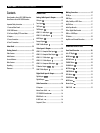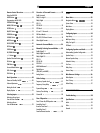
14
RSP-1098 Surround Sound Processor
VIDEO 1–5 Audio Inputs
Five pair of RCA inputs, labeled AUDIO IN
(VIDEO IN 1 – 5), provide connections for left/
right analog audio signals from five additional
source components. These inputs have corre-
sponding video inputs and are used for VCRs,
satellite TV tuners, DVD players, etc. However,
they may also be used for additional audio
only components, simply omitting the corre-
sponding video connections.
VIDEO 1–3 Audio Outputs
Three pair of RCA jacks, labeled AUDIO OUT
(VIDEO OUT 1 – 3), provide connections for
sending line level left/right line level analog
audio signals for recording to a VCR.
These connections correspond to the VIDEO
IN 1-3 connections. Make sure that you are
consistent. If you hook up a particular VCR to
the VIDEO 1 inputs, hook up the VIDEO 1 out-
puts to the same VCR.
NOTE
: There are no analog audio outputs for
VIDEO 4 & 5. Therefore, in an elaborate sys-
tem, hook up all of the VCRs and recording
devices to VIDEO 1–3 and use VIDEO 4 & 5
for playback only components.
NOTE
: Video 1–3 can be used for audio-only
tape decks, simply omitting the correspond-
ing video connections.
MULTI Inputs
A set of RCA inputs accept up to 7.1 chan-
nels of analog signals from a DVD-A or SACD
player. There are inputs for FRONT L & R,
CENTER, SUB, REAR L & R, and CENTER BACK
1 & 2.
These inputs bypass all digital processing in
the RSP-1098 and are routed directly to the
Volume control and preamp outputs
There are two subwoofer options for the MULTI
input. Normally, the .1 channel input is passed
through directly to the subwoofer output. An
optional bass redirect feature duplicates the
7 main channels, sums them, and sends this
mono signal through a 100 Hz analog low
filter to the subwoofer output. This provides
an unaltered analog bypass for the seven main
channels along with a subwoofer signal de-
rived from those channels.
Preamp Outputs
A group of ten RCA analog audio outputs sends
the RSP-1098’s line level output signals to
external amplifiers and powered subwoofers.
These outputs are variable level, adjusted by
the RSP-1098 volume control. The eight con-
nectors provide output for: FRONT L & R, CEN-
TER 1 & 2, SURROUND L & R, CENTER BACK
CB1 & CB2, and SUBWOOFER 1 & 2.
NOTE
: Depending on your system configura-
tion, you may use some or all of these con-
nections. For example, if you only have one
center channel, connect it to the CENTER 1
output. If you only have one center back chan-
nel, connect it to the CB1 output.
ZONE 2 Audio Outputs
A pair of RCA inputs, labeled AUDIO OUT/
ZONE 2, sending analog audio signals to an
external amplifier for a remote zone. These
outputs can be configured as either fixed or
variable level using the ZONE 2 SETUP menu.
NOTE
: Only analog input signals are avail-
able at the Zone 2 outputs. Source compo-
nents connected to only the digital inputs are
not available in Zone 2.
To configure your system for Zone 2 opera-
tion, connect the left and right Zone 2
outputs
on the RSP-1098 to the left and right channel
inputs
of the amplifier powering the remote
speakers, using standard RCA audio cables.
Video Inputs & Outputs
These connections are used for connecting
video signals to and from the RSP-1098. See
the
Making Connections
section for specific
instructions for each type of component.
The RSP-1098 provides Composite, S-Video,
and Component Video connections. Composite
video connections simplify system configura-
tion; however, S-Video connections typically
provide better picture quality. Component Video
connections are required for HDTV or progres-
sive scanned DVD video. Be aware of the fol-
lowing implications for the configuration of your
system:
On Screen Display: The RSP-1098 OSD
system is available on the TV monitor, regardless
of what type of connection is made from the
TV MONITOR outputs to the TV set. The OSD
system is also available in the TFT screen.
NOTE
: When using a progressive scan or 1080i
video signal from the Component Video in-
puts, the TV monitor cannot display the video
signal and the OSD menus at the same time.
A “progressive” setting in the Display Options
setup menu allows the use of the main OSD
setup menus, even with progressive or HDTV
signals. When the main OSD setup menus are
activated, the progressive scan video input is
interrupted and restored when the OSD menus
are cancelled. The temporary OSD informa-
tion displays (such as volume setting, etc.) are
not displayed. All of the OSD displays are avail-
able on the front-panel TFT screen.
Output Conversion: The RSP-1098 con-
verts composite and S-Video signals to Com-
ponent Video signals for output to an NTSC
or PAL standard TV monitor. For maximum con-
venience, connect the RSP-1098 to the TV moni-
tor with Component Video connections. S-Video
signals cannot be converted to composite out-
puts and vice versa.
NOTE
: When the progressive mode is set to
YES in the DISPLAY OPTIONS setup menu, the
conversion from composite or S-Video to Com-
ponent Video output is only available for the
VIDEO 5 input, not for the VIDEO 1–4 inputs.
Many digital HDTV monitors adjust scan rates
and other video parameters depending on the
type of input connection. You may wish to make
multiple connections between the RSP-1098
and the TV monitor, switching inputs on the
TV to take advantage of these features.
TFT Display: If you choose to display video
signals on the front panel display, keep in mind
that it can only display signals from sources
connected with composite video connections.
Even if you use Component Video connections,
it is recommended that you also make com-
posite video connections from each source
component to the RSP-1098 so that the sig-
nal from each source component can be dis-
played on the front panel TFT display.
NOTE
: The TFT display cannot properly dis-
play progressive scan (480p) signals. When
a DVD player is outputting a progressive scan
signal on Component Video outputs, its com-
posite video outputs may not provide a us-
able signal. In this case, the TFT screen will
not be able to display video from the DVD
player or may display distorted video, even
with a composite video connection.


















